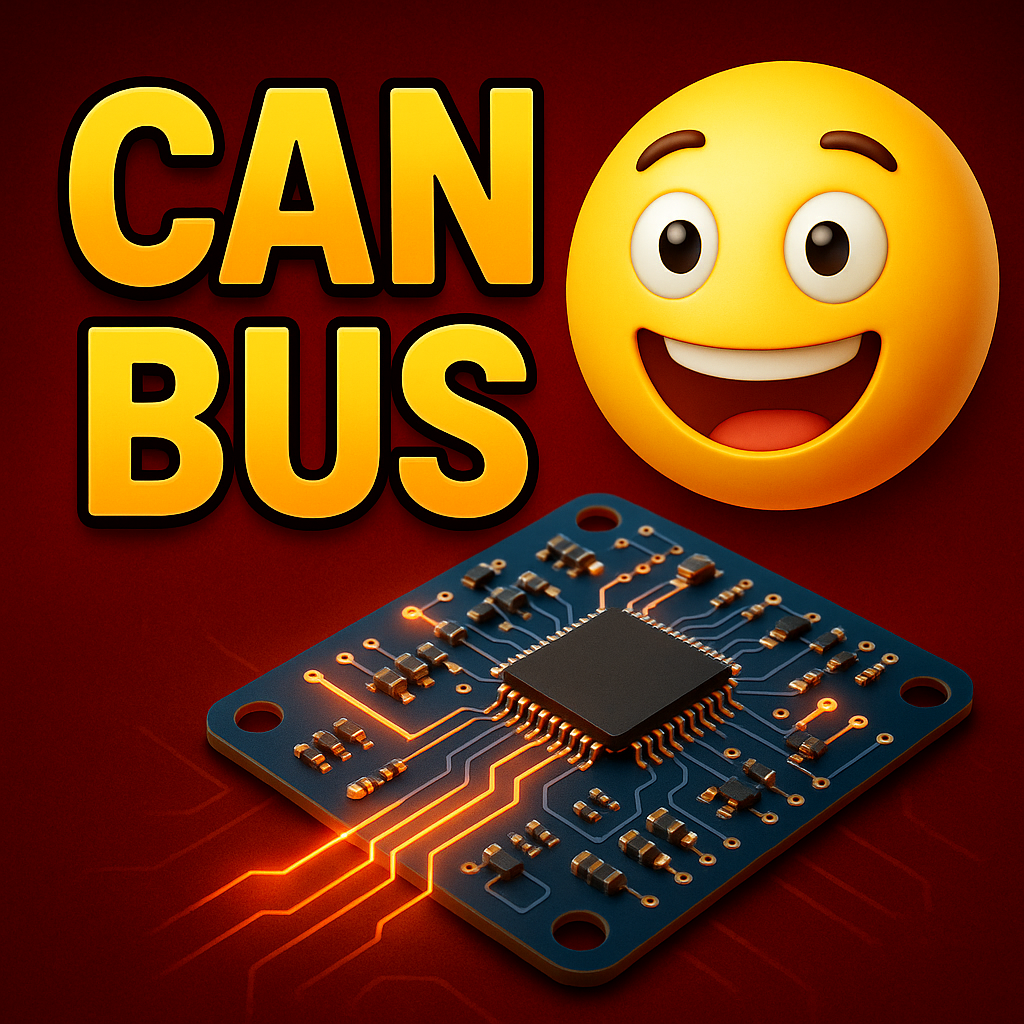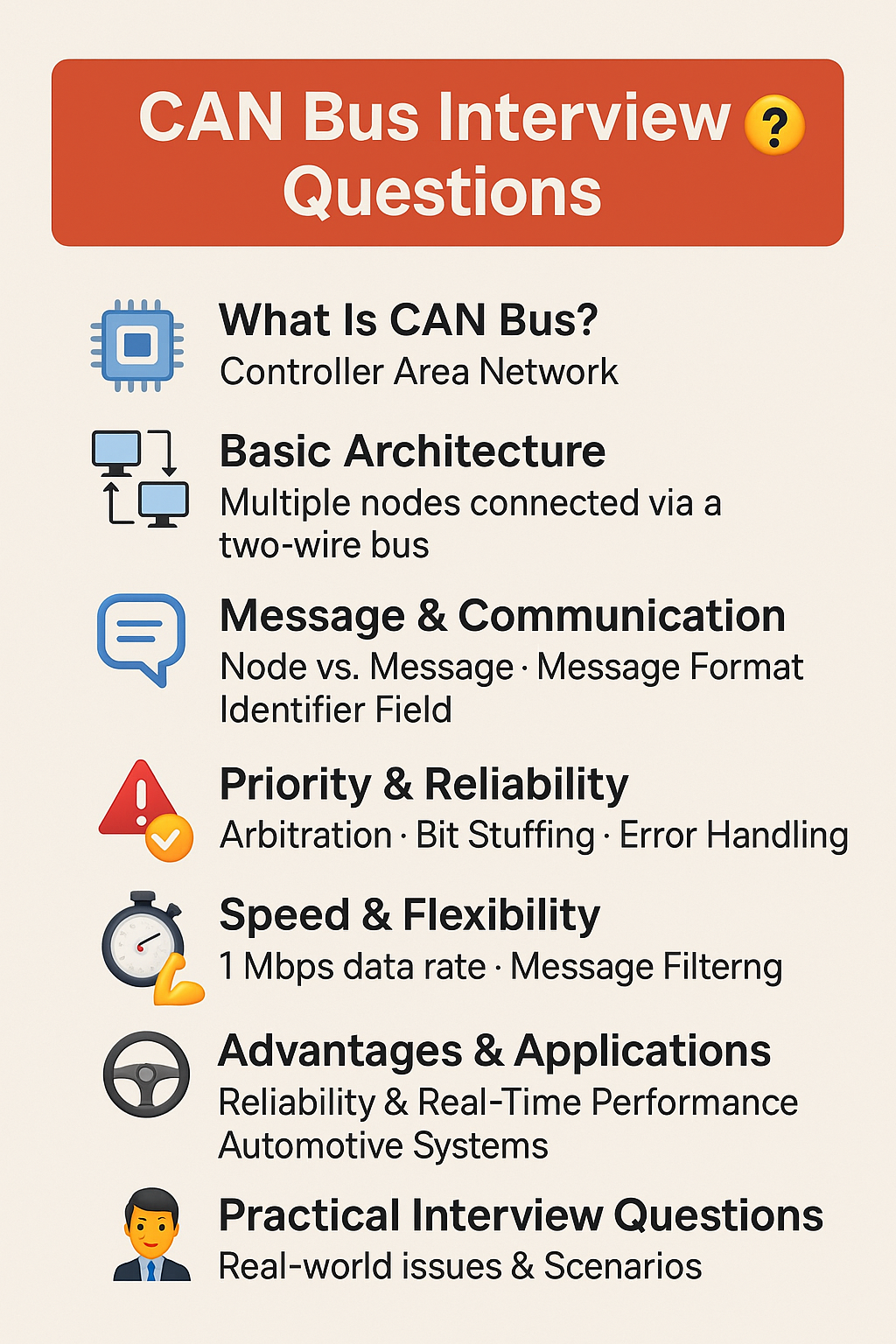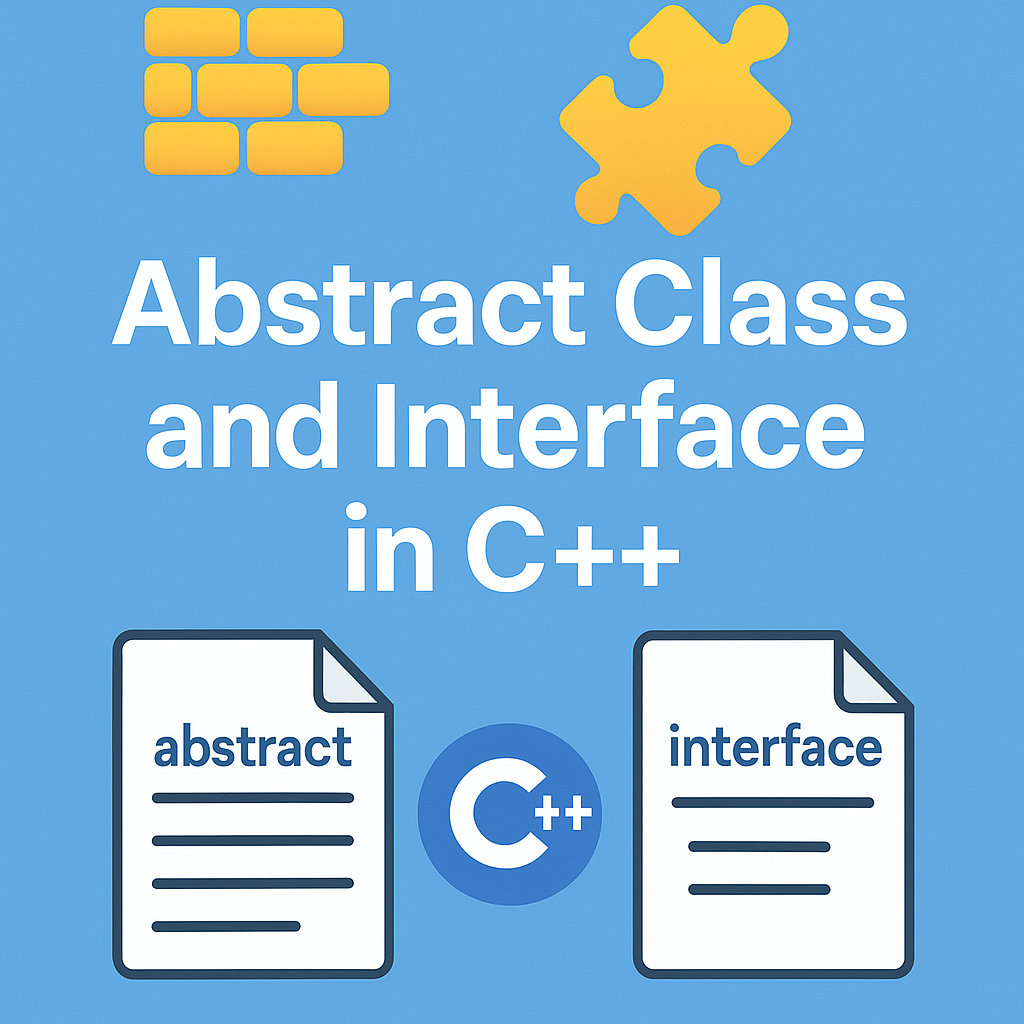CAN Bus Interview Questions : If you are preparing for an embedded systems or automotive interview, chances are you’ll face questions on CAN bus, a widely-used communication protocol in vehicles. This article simplifies CAN bus interview questions for beginners and helps you understand the key concepts, architecture, message handling, and real-world applications in a friendly tone.
Whether you’re a student, fresher, or experienced developer brushing up for an interview, this guide is a great place to start.
CAN Bus Interview Questions

Basic Concepts
- What does CAN stand for in CAN bus?
- What is CAN bus and why is it used in automotive systems?
- Describe the basic architecture of a CAN bus system.
- What are the primary components of a CAN bus network?
- Explain the difference between a CAN node and a CAN message.
Message Format and Communication
- Can you explain the message format used in CAN bus?
- What is the purpose of the CAN identifier field in a CAN message?
- Describe the difference between standard and extended CAN identifiers.
- How does CAN bus support prioritization of messages?
- Describe the process of arbitration in CAN bus communication.
Data Transmission & Reliability
- How does CAN bus ensure message integrity and reliability?
- How does CAN bus handle message collisions?
- How does CAN bus handle error detection and error handling?
- What is bit stuffing, and why is it used in CAN bus communication?
- What is the maximum data transfer rate supported by CAN bus?
Filtering, Speed, and Configuration
- Can you explain the concept of message filtering in CAN bus?
- How does CAN bus handle communication between nodes with different bit rates?
- How does CAN bus support both high-speed and low-speed communication within a vehicle?
- What factors should be considered when designing a CAN bus network?
Hardware & Physical Layer
- Explain the significance of termination resistors in a CAN bus network.
Applications & Real-World Use Cases
- What are the advantages of using CAN bus over other communication protocols in automotive applications?
- What are the advantages of using CAN bus in automotive applications?
- Describe a scenario where you would choose CAN bus over other communication protocols for a specific application.
- How does CAN bus contribute to the overall reliability and safety of automotive systems?
- Describe a scenario where you encountered a communication issue on a CAN bus and how you resolved it.
Suggested Additional Questions (Optional for Advanced Interviews)
- What is the function of ACK slot in CAN message frame?
- What happens if both nodes on a CAN bus transmit messages simultaneously with the same priority?
- What tools can be used to debug or monitor CAN bus activity?
- Can you explain the role of CAN transceivers?
- What’s the difference between CAN, LIN, and FlexRay protocols?
Frequently Asked Questions | CAN Bus Interview Questions
1.What is the CAN bus used for?
Answer: CAN (Controller Area Network) is used for communication between multiple electronic control units (ECUs) in vehicles and other embedded systems without needing a central host. It ensures fast, reliable, and real-time data exchange.
2.Is knowledge of CAN protocol important for embedded system engineers?
Answer: Yes. CAN is widely used in automotive and industrial systems, so understanding it is essential for embedded developers working with microcontrollers, ECUs, or automation.
3.What are the most common topics asked in CAN bus interviews?
Answer: Key topics include:
- CAN architecture
- Message format and identifiers
- Arbitration and prioritization
- Bit timing and error handling
- Termination resistors and filtering
4.What’s the difference between standard and extended CAN identifiers?
Answer: Standard identifiers are 11-bit long, while extended identifiers are 29-bit long, offering more unique message IDs and supporting complex systems.
5.How can I prepare for CAN bus interviews?
Answer:
- Understand how CAN works at both physical and protocol layers
- Study message structure, arbitration, and filtering
- Practice interpreting CAN frames using tools like CANalyzer, PCAN View, or BusMaster
- Review real-world issues and troubleshooting scenarios
6.Is CAN bus only used in automotive systems?
Answer: No. While it started in automotive, it’s also used in industrial automation, robotics, aerospace, and medical devices due to its robustness and fault tolerance.
7.What tools are used for working with CAN bus?
Answer: Common tools include:
- CANalyzer
- CANoe
- PCAN View
- BusMaster (open-source)
- Logic analyzers with CAN decoders
8.How can I explain a real-world CAN issue in an interview?
Answer: Be honest. For example, explain a scenario where a node failed due to missing termination or noise interference, how you diagnosed it using a CAN tool, and how you fixed it.
You can also Visit other tutorials of Embedded Prep
- Multithreading in C++
- Multithreading Interview Questions
- Multithreading in Operating System
- Multithreading in Java
- POSIX Threads pthread Beginner’s Guide in C/C++
- Speed Up Code using Multithreading
- Limitations of Multithreading
- Common Issues in Multithreading
- Multithreading Program with One Thread for Addition and One for Multiplication
- Advantage of Multithreading
- Disadvantages of Multithreading
- Applications of Multithreading: How Multithreading Makes Modern Software Faster and Smarter”
Mr. Raj Kumar is a highly experienced Technical Content Engineer with 7 years of dedicated expertise in the intricate field of embedded systems. At Embedded Prep, Raj is at the forefront of creating and curating high-quality technical content designed to educate and empower aspiring and seasoned professionals in the embedded domain.
Throughout his career, Raj has honed a unique skill set that bridges the gap between deep technical understanding and effective communication. His work encompasses a wide range of educational materials, including in-depth tutorials, practical guides, course modules, and insightful articles focused on embedded hardware and software solutions. He possesses a strong grasp of embedded architectures, microcontrollers, real-time operating systems (RTOS), firmware development, and various communication protocols relevant to the embedded industry.
Raj is adept at collaborating closely with subject matter experts, engineers, and instructional designers to ensure the accuracy, completeness, and pedagogical effectiveness of the content. His meticulous attention to detail and commitment to clarity are instrumental in transforming complex embedded concepts into easily digestible and engaging learning experiences. At Embedded Prep, he plays a crucial role in building a robust knowledge base that helps learners master the complexities of embedded technologies.



Leave a Reply